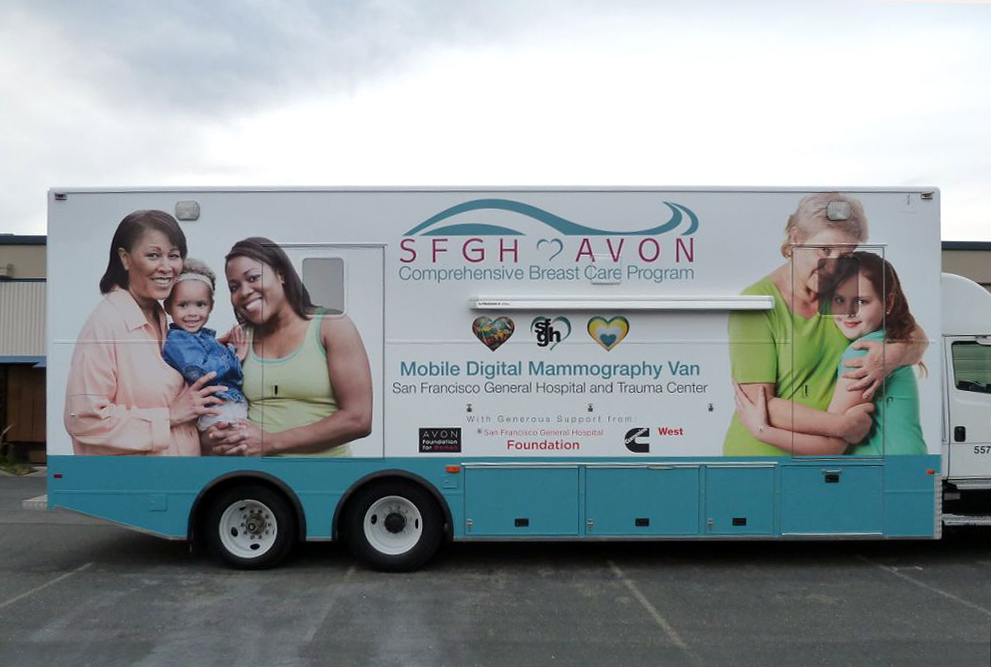Mary McGinty’s Quest to Reach Underserved Women & Remove Barriers to Accessing Breast Imaging Services
Mammography and biopsies are important tools in breast cancer detection and diagnosis, but some women face barriers both to access and understanding of the procedures.
Mary McGinty’s job is to remove those barriers, a mission worthy of spotlighting as we observe Breast Cancer Awareness Month in October.
McGinty is supervisor of the Avon Breast Center at Zuckerberg San Francisco General Hospital. She also oversees the Mobile Outreach Mammography Van, traveling several times a week to neighboring clinics in underserved areas to provide mammography screenings for women without health insurance.
 Through her work at both the clinic and the van, McGinty demonstrates the importance of patient-centered service and the positive impact of bringing mammography screening to patients who might otherwise not be reached because of lack of awareness or transportation.
Through her work at both the clinic and the van, McGinty demonstrates the importance of patient-centered service and the positive impact of bringing mammography screening to patients who might otherwise not be reached because of lack of awareness or transportation.
The team at the Avon Breast Center works hard to ensure that all patients are supported throughout their experience. Navigators, fluent in Chinese and Spanish, greet patients and help them overcome language barriers. The navigators offer emotional support as well, even holding hands with the patient as she undergoes a biopsy. The navigators that help serve patients at ZSFG Avon Breast Center are critical for care coordination.
The Avon Breast Center offers the latest state-of-the-art equipment including digital breast tomosynthesis, which provides multiple small pictures of breast tissue as the scanner moves in an arc, in addition to standard digital mammography tools. “In our experience, tomosynthesis reduces callbacks by about 25 percent, making it incredibly useful if it’s your first mammogram,” says McGinty. The center works in partnership with the pathology staff at ZSFG, so if a patient or provider feels a lump, pathology will be there in minutes to perform a fine needle aspiration (FNA) and examine the sample under a microscope. Instead of sending the patient home, the team at the center is able to begin the diagnostic right away, a true representation of ZSFG and UCSF’s world-class patient care. This also demonstrates a true meaning of a comprehensive breast center.
This level of patient care extends from the clinic to the Mobile Outreach Mammography Van, which decreases transportation barriers. Instead of the patient coming to the clinic, the clinic comes to the patient. “Out in the community, we are serving the underserved and the patients that do not have insurance,” says McGinty. Eligibility workers match patients without insurance with programs that allow them to receive screening, a diagnostic, an MRI, and a biopsy if needed.
The van goes out into the community 2-3 times a week. Again, the emphasis is on patient-centered care. When a patient enters the van, she can sit on a sofa (aptly filled with pink pillows) and fill out necessary forms. Then she is provided a changing room to prepare for the procedure once she is called by the technologist. The van has a full-field digital mammography unit, just like the Avon Breast Center. When the van returns to the center, images are electronically sent to doctors.
The aim of the van is to reach more women with mammography screening. McGinty is concerned about not only getting more women screened, but also about getting them screened earlier. In particular, she is interested in African-American women, who often present with later stage breast cancer.
In the van and at the clinic, McGinty stresses the value of customer service and lessons she learned from prior experience in retail. She especially appreciates feedback from patients, who are given feedback forms that allow them to share their thoughts on their mammogram experience. She puts these forms up on a “Think Positive” board for everyone at the center to see. The team board serves to track and encourage progress. “Together everyone achieves more,” says one poster.
